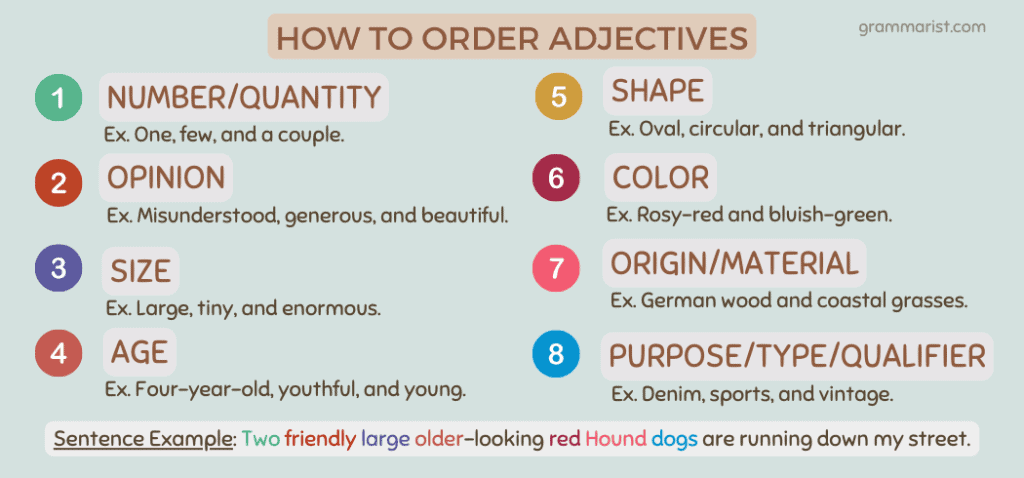The English language is defined by various parts of speech that help you make messages clear to your audience. The details you add to your speech and writing are especially important to ensure you are understood.
When describing things, you need to follow a specific order of detail. Adjectives are words that provide detail, and the rules of order of adjectives help you keep your writing clear and concise to avoid confusion.
Let’s look at what this means and how you can use it to your advantage.
What Is an Adjective?
Adjectives are an important part of speech that add interest to the nouns and pronouns in your sentences. They modify a noun or pronoun to provide much more information to your sentences and can answer questions such as “which one,” “what kind,” and “whose is it.”
For example, this basic sentence provides a subject and object, but there isn’t much detail:
- Donna picked up the books from the library.
Once you add adjectives, the sentence becomes much more interesting:
- Donna picked up the art books from the new library.
What Does an Order of Adjectives Mean?

Although the rules of adjective order are not attributed to any one grammar rule (and some controversy over which order some details belong in exists), there are some generally accepted ways to use multiple adjectives in your speech and writing.
Most people order adjectives according to what sounds “right” rather than “wrong” and follow a set pattern of speech. This pattern has become widely accepted as the correct way to list adjectives when modifying nouns and pronouns for detail and clarity.
Another way to explain this is the closer an adjective is to the noun, the more important it is to the noun’s description.
How to Order Adjectives
It is common to use a pair of adjectives (or more) when describing a noun, and their order should be consistently used from one sentence to another. For example, you may want to describe the physical qualities of a person along with their disposition so you would need to list this in the proper order.
The accepted order of descriptive adjectives (with slight variations to accommodate word flow) is as follows:
Number/Quantity
The amount of your noun goes first. For example, one, few, many, six, and a couple.
Opinion
An opinion adjective about the noun helps an audience determine what the author feels about the noun. For example, words such as misunderstood, valuable, downtrodden, generous, and beautiful help describe a noun.
Size
The size of the noun belongs toward the beginning of your description. For example, large, small, tiny, minute, and enormous provide the reader with an idea of how much space is taken up.
Age
Age can be described as a year, such as four-year-old, or can be descriptive, such as old, youthful, elderly, and young.
Shape
Use shapes such as oval, circular, rectangular, and triangular.
Color
Descriptive colors belong closer to the nouns. Feel free to use compound color options as well, such as rosy-red, bluish-green, and pasty-white.
Origin/Material
Depending on who you ask, the origins of a noun could also mean the materials of the noun. If you happen to use both a physical location for the origin and a material, place the origin first. For example, German wood, coastal grasses, Western lumber, European spring water, and mountain air.
Purpose/Type/Qualifier
This is another category that can be interpreted differently. The purpose of your noun, such as whether it is sleep, driving, and running, trumps the type (or qualifying detail). Qualifying details include things like Hound, denim, sports, and vintage.
Noun
The noun being described naturally comes last!
For example:
- Two friendly large older-looking red Hound dogs are running down my street.
How to Punctuate a Series of Adjectives in a Sentence
Punctuating a list of two or more adjectives in a sentence is actually very easy. Some require a comma, and some do not. These two simple rules of comma usage will help you keep your sentences properly punctuated:
Comma Rule #1
When two or more adjectives come from the same category, they need to be separated by commas.
For example:
- I took my versatile, comfortable, dependable car on a road trip.
Comma Rule #2
When two or more adjectives come from different categories, no commas are needed.
For example:
- The three bossy large white geese reign over the barnyard.
Also, never place a comma between the final adjective and the noun.
Order of Adjectives Chart
Number/Quantity
seven
Opinion
lovely
Size
large
tiny
Age
old
Shape
square
thin
Color
green
Origin/Material
Italian
cotton
Purpose/Type/Qualifier
sleeping
modern
Let’s Review
Adjectives are descriptive words that modify nouns and pronouns in sentences. Their addition adds details and clarification to the spoken and written word. However, if you use more than one, they should be placed in a specific order according to what they are describing.
Although why they are placed in the order they are has no specific origin, the more important details have a tendency to be placed closer to the noun they describe.